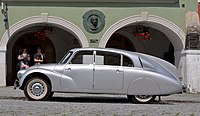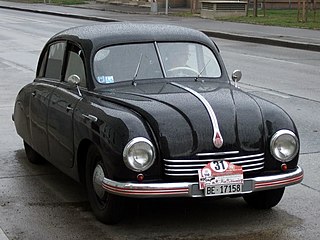
The Tatra 600, named the Tatraplan, was a rear-engined large family car produced from 1948 to 1952 by the Czech manufacturer Tatra. The first prototype was finished in 1946.

The Volkswagen Beetle, officially the Volkswagen Type 1, is a small family car produced by the German company Volkswagen from 1938 to 2003. One of the most iconic cars in automotive history, the Beetle is noted for its distinctive shape. Its production period of 65 years is the longest of any single generation of automobile, and its total production of over 21.5 million is the most of any car of a single platform.

Tatra is a Czech vehicle manufacturer from Kopřivnice. It is owned by the TATRA TRUCKS a.s. company, and it is the third oldest company in the world producing motor vehicles with an unbroken history. The company was founded in 1850 as Ignatz Schustala & Cie. In 1890 the company became a joint-stock company and was renamed the Nesselsdorfer Wagenbau-Fabriksgesellschaft. In 1897, the Nesselsdorfer Wagenbau-Fabriksgesellschaft produced the Präsident, which was the first factory-produced automobile with a petrol engine to be made in Central and Eastern Europe. The First Truck was made a year later, in 1898. In 1918, the company was renamed Kopřivnická vozovka a.s., and in 1919 it changed from the Nesselsdorfer marque to the Tatra badge, named after the nearby Tatra Mountains on the Czechoslovak-Polish border.

Hans Ledwinka was an Austrian automobile designer.

In automotive design, an RR, or rear-engine, rear-wheel-drive layout places both the engine and drive wheels at the rear of the vehicle. In contrast to the RMR layout, the center of mass of the engine is between the rear axle and the rear bumper. Although very common in transit buses and coaches due to the elimination of the drive shaft with low-floor buses, this layout has become increasingly rare in passenger cars.

The Porsche 114 was a 1938 proposed design for a sports car powered by a 1493 cc V10 engine.

The Tatra 77 (T77) is one of the first serial-produced, truly aerodynamically-designed automobiles, produced by Czechoslovakian company Tatra from 1934 to 1938. It was developed by Hans Ledwinka and Paul Jaray, the Zeppelin aerodynamic engineer. Launched in 1934, the Tatra 77 is a coach-built automobile, constructed on a platform chassis with a pressed box-section steel backbone rather than Tatra's trademark tubular chassis, and is powered by a 60 horsepower (45 kW) rear-mounted 2.97-litre air-cooled V8 engine, in later series increased to a 75 horsepower (56 kW) 3.4-litre engine. It possessed advanced engineering features, such as overhead valves, hemispherical combustion chambers, a dry sump, fully independent suspension, rear swing axles and extensive use of lightweight magnesium alloy for the engine, transmission, suspension and body. The average drag coefficient of a 1:5 model of Tatra 77 was recorded as 0.2455. The later model T77a, introduced in 1935, has a top speed of over 150 km/h (93 mph) due to its advanced aerodynamic design which delivers an exceptionally low drag coefficient of 0.212. Sources claim that this is the coefficient of a 1:5 scale model, not of the car itself, so the actual drag coefficient may have been slightly higher.

The Tatra 87 (T87) is a car built by Czechoslovak manufacturer Tatra from 1936 to 1950. It was powered by a rear-mounted 2.9-litre air-cooled 90-degree overhead cam V8 engine that produced 85 horsepower and could drive the car at nearly 100 mph (160 km/h). It is ranked among the fastest production cars of its time. Competing cars in this class, however, used engines with almost twice the displacement, and with fuel consumption of 20 liters per 100 km. Thanks to its aerodynamic shape, the Tatra 87 had a consumption of just 12.5 litres per 100 km. After the war between 1950 and 1953, T87s were fitted with more-modern 2.5-litre V8 T603 engines.

The Tatra 80 is a Czechoslovak luxury full-size car built by Tatra between 1931 and 1935.
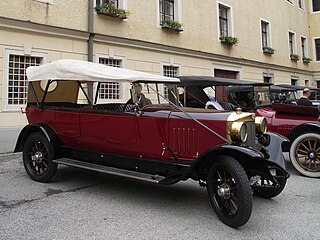
Steyr was an Austrian automotive brand, established in 1915 as a branch of the Österreichische Waffenfabriks-Gesellschaft (ÖWG) weapon manufacturing company. Renamed Steyr-Werke AG in 1926 and merged with Austro-Daimler and Puch into Steyr-Daimler-Puch AG, it continued manufacturing Steyr automobiles until 1959.

The Tatra 603 is a large rear-engined luxury car which was produced by the Czechoslovak company Tatra from 1956 to 1975. It was a continuation of the series of Tatra streamlined sedans which began with the Tatra 77. In Socialist Czechoslovakia, only high-ranking party officials and heads of factories were driven in 603s; the car was also exported to a number of other countries.

From 1931 to 1939, Daimler-Benz AG produced three cars with rear engine as well as a few prototypes. Production numbers remained low for each of these models, especially compared with the production of conventional front-engine Mercedes-Benz cars.

Erich Übelacker was a German automobile engineer.

The Tatra 70 is a Czechoslovak luxury car that was made by Tatra at Kopřivnice from 1931 to 1937. It succeeded the Tatra 31.
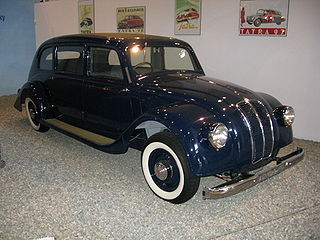
The Tatra 90 is a Czechoslovak prototype mid-size car, made by Tatra in Kopřivnice in 1935.
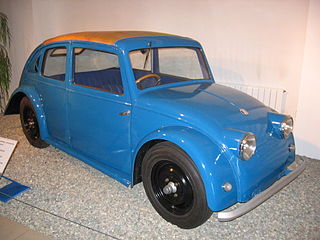
The Tatra V570 was a prototype 1931-33 car developed by a team led by Hans Ledwinka, Erich Ledwinka and Erich Übelacker. The aim of the construction team was to develop a cheap people's car with an aerodynamic body. The first T57-V570 prototype with rear air-cooled two-cylinder engine placed in the former rear luggage compartment of conventional T57 two-seater dropped head coupe was completed late in 1931. However, the company's management decided that the revolutionary ideas introduced in the prototype should be introduced in large luxurious cars, and therefore the team abandoned the project of small cars in favour of the Tatra T77, the world's first serially produced aerodynamic car. The project of a small car was later continued and led to introduction of the Tatra T97. The second, now streamlined V570 four-seater was built in 1933, two years before the first Volkswagen, which bears a strong resemblance to the Tatra – it was misappropriated in the opinion of Tatra, by Adolf Hitler and Dr. Ferdinand Porsche in circumstances about which the German company remains intensely sensitive.

The Präsident was an automobile manufactured by the Nesselsdorfer Wagenbau-Fabriks-Gesellschaft, since 1919 Tatra, in 1897. It was the first practical, factory-produced petrol engine automobile built in Central and Eastern Europe. It was constructed by Leopold Sviták and Hans Ledwinka. The automobile was more of a carriage without horses than a car in modern sense. The car is steered via handlebars. The wooden bodywork is placed on an iron frame. It has four seats and a convertible top that would cover only the rear seats. Both axles have suspension of semi-elliptical leaf springs. The wheels were similar to the ones of a horse carriage, but had rubber tyres. The car had a two cylinder spark ignition Benz engine placed by the rear axle.
The NW Elektromobil is an automobile from the veteran era manufactured by the Nesselsdorfer Wagenbau-Fabriks-Gesellschaft (NW), now Tatra, from 1900–1901. Only two cars, which were ordered by Emil Kolben's company, Elektrotechnická a. s., based in Vysočany, Prague, were produced. The two Elektromobils had factory numbers 77 and 83.

The Tatra 52 is a Czechoslovak mid-size car that was made by Závody Tatra from 1931 to 1939. It was built both at the Tatra factory in Kopřivnice and also under licence by Rohr at Frankfurt am Main in Germany.

The Škoda 932 was an experimental prototype small four-seater car prototype made by the Czechoslovak manufacturer Škoda. The streamlined body was made of mixed wood/steel construction, the engine was installed at the rear. Only one unit was made.


























